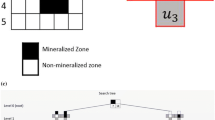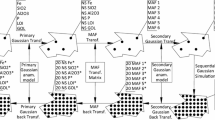Abstract
The present study developed a geostatistical simulation technique based on non-Gaussian copula for recoverable reserve estimation considering support effect of a well-known open-pit mine of a copper deposit in India. The focus was to examine the efficacy of copula-based simulation model in recoverable reserve estimation. It was assessed by comparing three selectivity curves like grade–ore tonnage, grade–metal tonnage and ore–metal tonnage of reserve constructed using the copula-based simulation, disjunctive kriging and multi-Gaussian kriging with respect to the production data of blasting. The results informed that the copula-based simulation technique provided better accuracy than the nonlinear geostatistical techniques of disjunctive kriging and multi-Gaussian kriging. The root mean square error and standard error analysis indicated that the copula-based simulation model provided more accurate estimates compared with disjunctive kriging and multi-Gaussian kriging. All the three techniques yielded biased estimates, but the least bias was attributed to the copula-based simulation technique.

















Similar content being viewed by others
References
Badel, M., Angorani, S., & Panahi, M. S. (2011). The application of median indicator kriging and neural network in modeling mixed population in an iron ore deposit. Computers & Geosciences, 37(4), 530–540.
Bárdossy, A. (2006). Copula-based geostatistical models for groundwater quality parameters. Water Resources Research, 42(11), 11416.
Bárdossy, A., & Li, J. (2008). Geostatistical interpolation using copulas. Water Resources Research, 44(7), 07412.
Bouyé, E., Durrleman, V., Nikeghbali, A., Riboulet, G., & Roncalli, T. (2000). Copulas for finance-a reading guide and some applications. Available at SSRN 1032533.
Chiles, J. P., & Delfiner, P. (1999). Geostatistics modeling spatial uncertainty. Wiley series in probability and statistics. New York: John Wiley Sons. Inc.
Cressie, N. (1985). Fitting variogram models by weighted least squares. Journal of the International Association for Mathematical Geology, 17(5), 563–586.
Embrechts, P., McNeil, A., & Straumann, D. (2002). Correlation and dependence in risk management: properties and pitfalls. Risk Management: Value at Risk and Beyond, 1, 176–223.
Emery, X. (2002). Conditional simulation of nongaussian random functions. Mathematical Geology, 34(1), 79–100.
Emery, X., & Torres, J. F. S. (2005). Models for support and information effects: A comparative study. Mathematical Geology, 37(1), 49–68.
Genest, C., & Favre, A. C. (2007). Everything you always wanted to know about copula modeling but were afraid to ask. Journal of Hydrologic Engineering, 12(4), 347–368.
Genest, C., & MacKay, R. J. (1986). Copules archimédiennes et families de lois bidimensionnelles dont les marges sont données. Canadian Journal of Statistics, 14(2), 145–159.
Goovaerts, P. (1997). Geostatistics for natural resources evaluation. Oxford: Oxford University Press.
Huijbregts, C. J. (1971). Universal kriging. In Proceedings of the International Symposium on Techniques for Decision-Making in Mineral Industry, 1971 (pp. 159–169).
Joe, H. (1997). Multivariate models and multivariate dependence concepts. London: Chapman & Hall.
Joe, H., & Xu, J. J. (1996). The estimation method of inference functions for margins for multivariate models.
Journel, A. G. (1974). Geostatistics for conditional simulation of ore bodies. Economic Geology, 69(5), 673–687.
Journel, A. G. (1983). Nonparametric estimation of spatial distributions. Journal of the International Association for Mathematical Geology, 15(3), 445–468.
Journel, A. G., & Huijbregts, C. J. (1978). Mining Geostatistics (Vol. 600). London: Academic press.
Kazianka, H., & Pilz, J. (2011). Bayesian spatial modeling and interpolation using copulas. Computers & Geosciences, 37(3), 310–319.
Keogh, A., & Moulton, C. (1998). Median indicator kriging—a case study in iron ore. In Proceedings of a one day symposium: Beyond Ordinary Kriging (pp. 106–120).
Kotz, S., Balakrishnan, N., & Johnson, N. L. (2004). Continuous multivariate distributions, Volume 1: Models and applications. New York: John Wiley & Sons. Inc.
Li, D. X. (2000). On default correlation: A copula function approach. The Journal of Fixed Income, 9(4), 43–54.
Marchant, B. P., Saby, N. P. A., Jolivet, C. C., Arrouays, D., & Lark, R. M. (2011). Spatial prediction of soil properties with copulas. Geoderma, 162(3–4), 327–334.
Matheron, G. (1963). Principles of geostatistics. Economic Geology, 58(8), 1246–1266.
Matheron, G. (1976b). A simple substitute for conditional expectation: the disjunctive kriging. In Advanced geostatistics in the mining industry (pp. 221–236). Springer, Dordrecht.
Mejía, J. M., & Rodríguez-Iturbe, I. (1974). On the synthesis of random field sampling from the spectrum: An application to the generation of hydrologic spatial processes. Water Resources Research, 10(4), 705–711.
Melchiori, M. R. (2003). Which Archimedean copula is the right one? YieldCurve, October.
Musafer, G. N., Thompson, M. H., Kozan, E., & Wolff, R. C. (2013). Copula-based spatial modelling of geometallurgical variables. In Proceedings of the second AusIMM international geometallurgy conference (pp. 239–246). The Australasian Institute of Mining and Metallurgy (AusIMM).
Musafer, G. N., Thompson, M. H., Kozan, E., & Wolff, R. C. (2017). Spatial pair-copula modeling of grade in ore bodies: A case study. Natural Resources Research, 26(2), 223–236.
Nelsen, R. B. (1999). An introduction to copulas. New York: Springer.
Nowak, M., & Verly, G. (2005). The practice of sequential Gaussian simulation. Geostatistics Banff 2004 (pp. 387–398). Dordrecht: Springer.
Ravenscroft, P. J. (1992). Recoverable reserve estimation by conditional simulation. Geological Society, London, Special Publications, 63(1), 289–298.
Rivoirard, J. (1989). Models with orthogonal indicator residuals. Geostatistics (pp. 91–107). Dordrecht: Springer.
Rivoirard, J. (1994). Introduction to disjunctive kriging and non-linear geostatistics (No. 551.021 R626i). Clarendon Press.
Salvadori, G., De Michele, C., Kottegoda, N. T., & Rosso, R. (2007). Extremes in nature: an approach using copulas (Vol. 56). Netherlands: Springer.
Sklar, A., Sklar, A., & Sklar, C. A. (1959). Fonctions de reprtition an dimensions et leursmarges.
Thakur, M., Samanta, B., & Chakravarty, D. (2014). Support and information effect modeling for recoverable reserve estimation of a beach sand deposit in India. Natural Resources Research, 23(2), 231–245.
Thakur, M., Samanta, B., & Chakravarty, D. (2018). A non-stationary geostatistical approach to multigaussian kriging for local reserve estimation. Stochastic Environmental Research and Risk Assessment, 32(8), 2381–2404.
Verly, G. (1983). The multigaussian approach and its applications to the estimation of local reserves. Journal of the International Association for Mathematical Geology, 15(2), 259–286.
Verly, G., & Sullivan, J. (1985). Multigaussian and probability krigings-application to the Jerritt Canyon deposit. Mining Engineering, 37(6), 568–574.
Acknowledgments
This work is carried out under the funded project of Ministry of Mines, India. Both the authors gratefully acknowledge this funding.
Author information
Authors and Affiliations
Corresponding author
Rights and permissions
About this article
Cite this article
Dinda, K., Samanta, B. Non-Gaussian Copula Simulation for Estimation of Recoverable Reserve in an Indian Copper Deposit. Nat Resour Res 30, 57–76 (2021). https://doi.org/10.1007/s11053-020-09734-z
Received:
Accepted:
Published:
Issue Date:
DOI: https://doi.org/10.1007/s11053-020-09734-z




